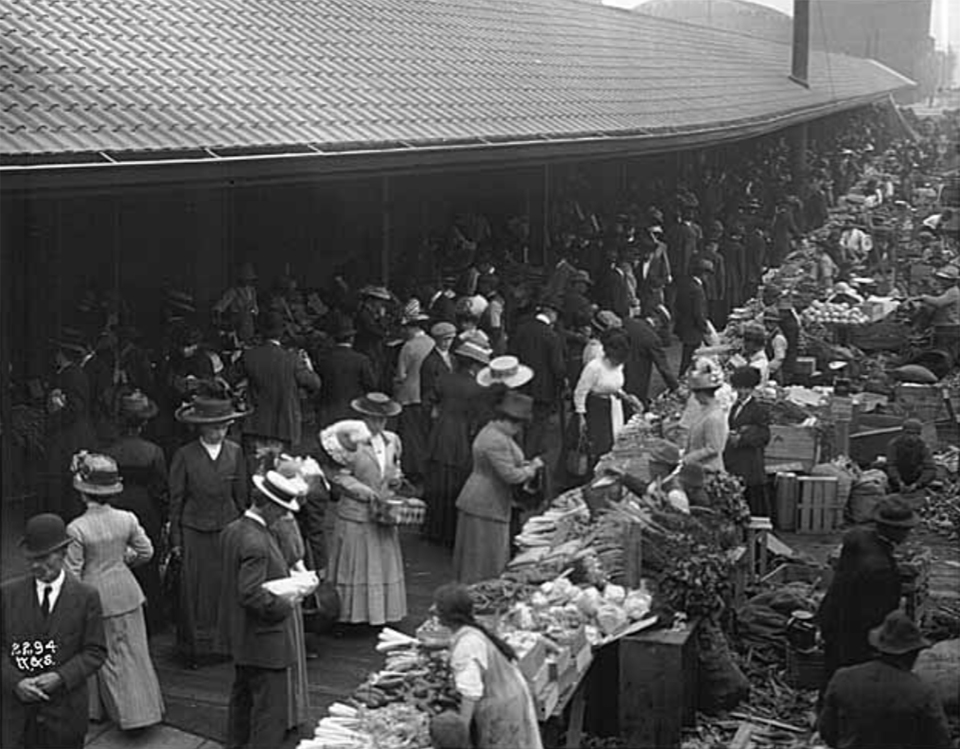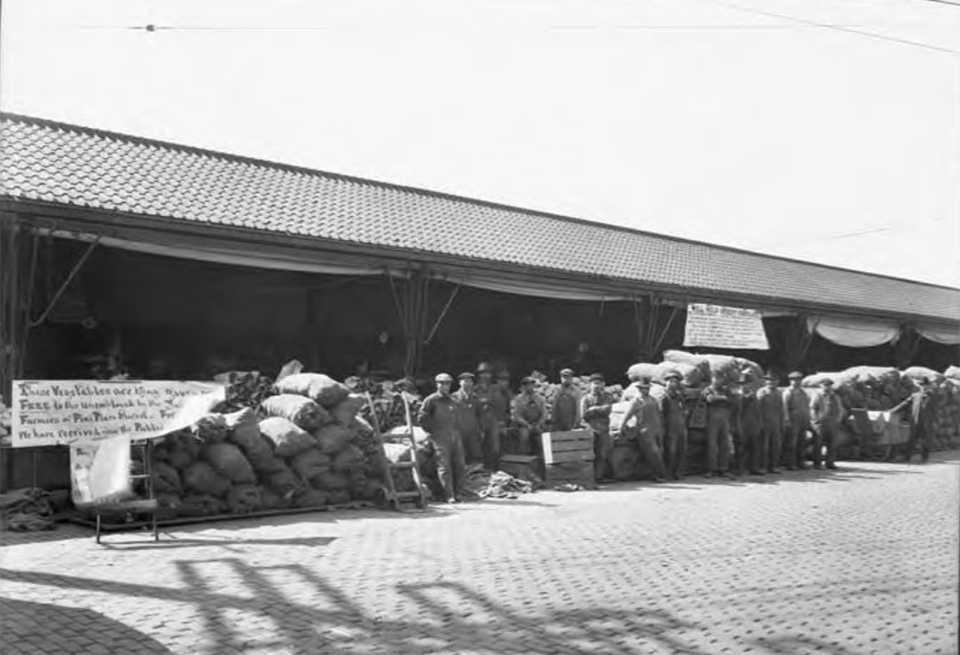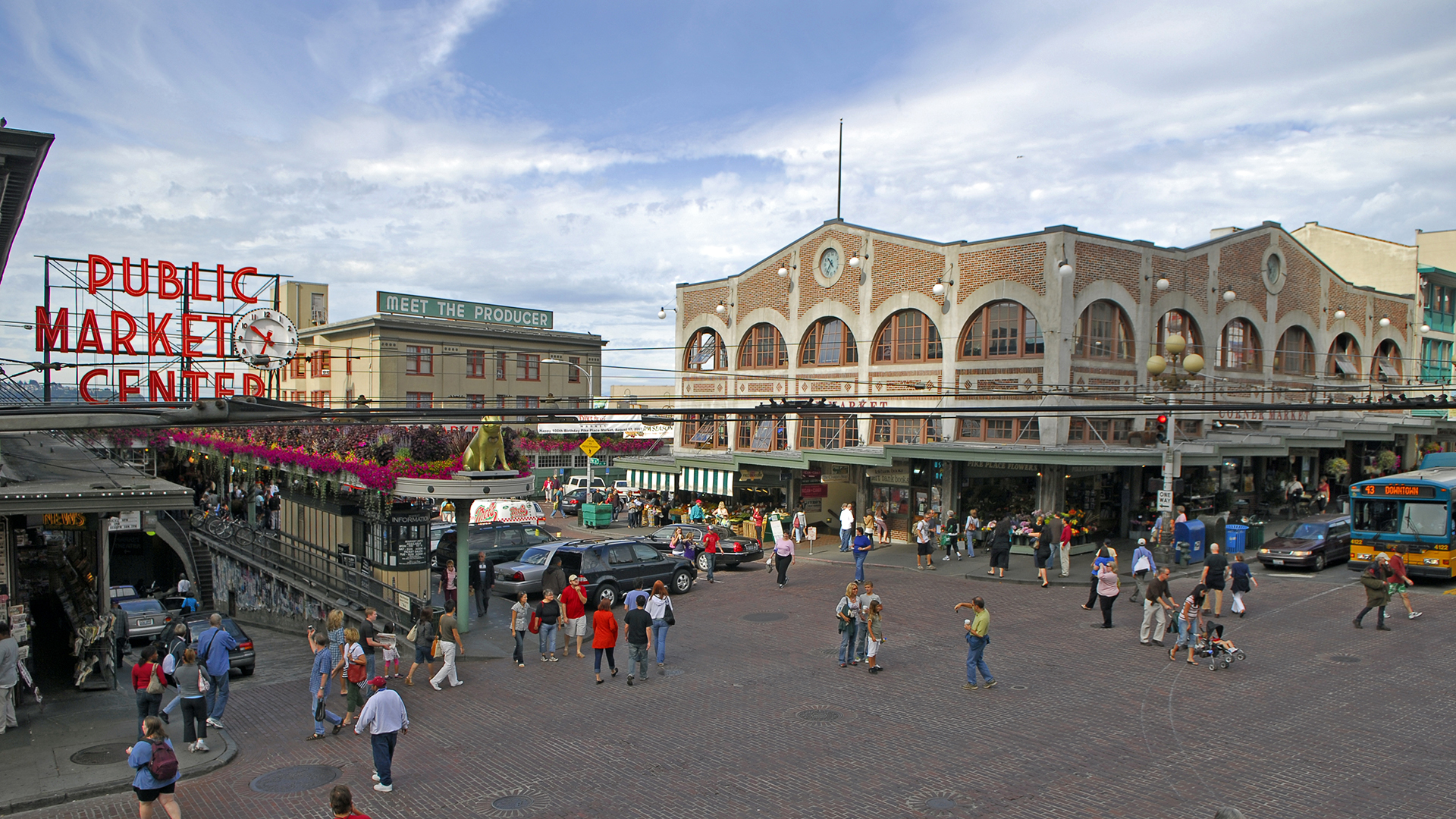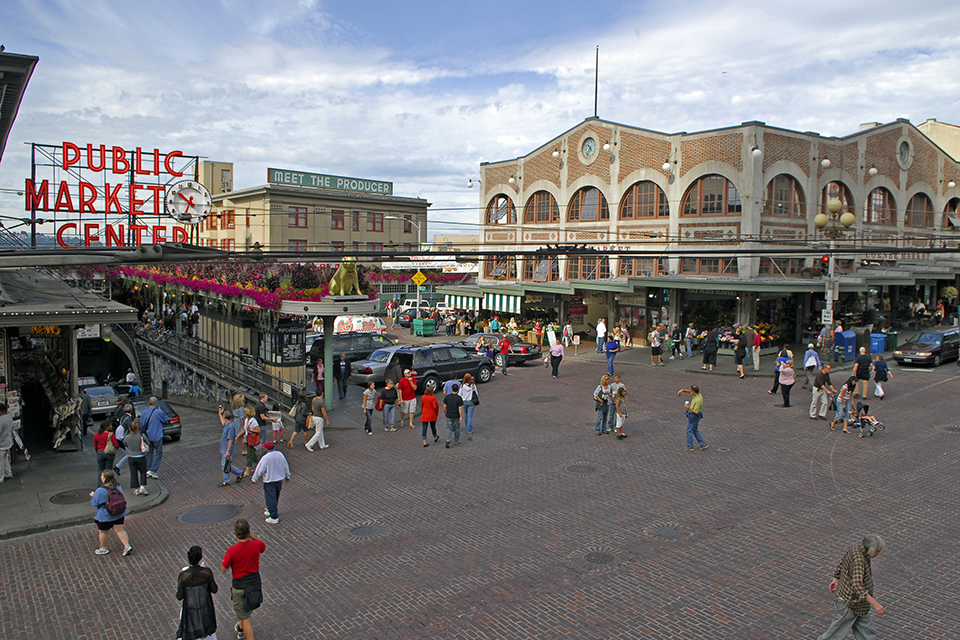It started with a meeting in Lowell’s Café in Pike Place Market in 1964. A group of citizens came together and ultimately formed Friends of the Market, an advocacy group that not only succeeded in preventing the demolition of the market, which had been operating since 1907, but in creating what is now a culturally significant nine-acre historic district that is listed in the National Register of Historic Places. The group was led by architect Victor Steinbrueck and their efforts, which began two years before the creation of the National Historic Preservation Act of 1966, would also attract the support of landscape architects Laurie Olin and Richard Haag. It was an early and powerful example of effective citizen-led advocacy that provides inspiration, and a road map, for future advocates.
History
Ordinance 16636 “Designating ‘Pike Place’ in the City of Seattle as a place for the sale of garden, farm and other products from wagons, or other similar vehicles, under certain conditions,” which was passed by the City Council on August 5, 1907, and signed two days later by Acting Mayor Charles Hiram Burnett, Jr., created what became one of the nation’s largest and longest continually operating farmer’s markets. Vendors set up for the first time on Saturday, August 17, 1907, and could operate from “five o’clock a. m. to twelve o’clock noon of each day, except Sunday.” It was an immediate success; the handful of vendors on the opening day grew to 70 the following Saturday.
 Shoppers and Farmers, ca. 1911. PEMCO Webster & Stevens Collection. Courtesy Museum of History & Industry, Seattle.
Shoppers and Farmers, ca. 1911. PEMCO Webster & Stevens Collection. Courtesy Museum of History & Industry, Seattle.
The chaotic street market, under the aegis of local entrepreneur Frank Goodwin, became an organized system of stalls. Today the main market complex and the surrounding streetscapes and commercial and residential buildings are a distinctive collection of vernacular and architect-designed properties and several of them pre-date the establishment of the farmers’ street market in 1907. Nearly all the historic properties within the district were constructed prior to 1922, by which time the marketing district exhibited the essential form and configuration that exists today.
 Corner Market at Pike Place Shoppers and Farmers, ca. 1915. PEMCO Webster & Stevens Collection. Courtesy Museum of History & Industry, Seattle.
Corner Market at Pike Place Shoppers and Farmers, ca. 1915. PEMCO Webster & Stevens Collection. Courtesy Museum of History & Industry, Seattle.
The long social history of the Pike Place Public Market involves a tremendously diverse ethnic and cultural mixture of farmers, shoppers, merchants, and residents. Since its inception shoppers, tourists and visitors from all income levels and social backgrounds have frequented the market to purchase everything from fancy fresh produce and gourmet specialty food items to day-old bread, inexpensive groceries and second-hand goods. Market farmers and merchants have hailed from many different nations, speaking many languages, a reflection of the on-going waves of immigration to the Puget Sound and Pacific Northwest region.
 Japanese farmers with their food donations for the poor, ca. 1911. Courtesy Museum of History & Industry, Seattle.
Japanese farmers with their food donations for the poor, ca. 1911. Courtesy Museum of History & Industry, Seattle.
At its peak in the 1930s the market was issuing more than 600 vendor permits, and the majority were Japanese American. Unfortunately, the World War II-era internment of Japanese Americans beginning in April 1942 radically shrank the number of permit holders to under 100. During the postwar era, particularly the 1950s and 1960s, new highways connected people to growing suburbs and their supermarkets, which sapped the market of customers. Physical deterioration and neglect also led to the market’s decline.
In 1963, the Seattle City Council adopted a comprehensive plan (known as the Monson Plan) that proposed encircling the Central Business District with a concentric ring road system including parking garages and parking lots at the perimeters - emulating the suburban shopping center model. The first major development project within this plan focused on the redevelopment of the entire Pike Place Market area. By early 1964 the initial “Pike Place Area Project” feasibility study was completed in a joint effort undertaken by the Central Association and the Seattle Urban Renewal Office. This study concluded that the buildings within a twelve and one-half acre area around the Pike Place Market (referred to as the Pike Plaza area) were generally blighted and under state and federal statutes would qualify for urban redevelopment funding.
The study recommended clearance and redevelopment of the area to construct a 3,000-car garage, high-rise office towers and a hotel, but was vague as to the treatment of the historic core market buildings and farmers market activities at the foot of Pike Street. What became known as the Pike Plaza Redevelopment Project was enthusiastically supported by the mayor, influential downtown business interests, and most civic leaders, as well as the major local media outlets and newspapers. However, University of Washington architecture professor Victor Steinbrueck, an architect of the 605-foot-tall Space Needle that opened as part of the 1962 World’s Fair, and artist Mark Tobey expressed early and persistent opposition to the modernization proposals. What started with a meeting in Lowell’s Café in Pike Place Market in 1964 became Friends of the Market (FOM), a determined advocacy organization that would spend years working to prevent the market’s destruction.
 Demonstration by the Friends of the Market, 1971. Seattle Post-Intelligencer Collection. Courtesy Museum of History & Industry, Seattle.
Demonstration by the Friends of the Market, 1971. Seattle Post-Intelligencer Collection. Courtesy Museum of History & Industry, Seattle.
From the outset, FOM members actively met with and lobbied local civic leaders, elected representatives and public officials and they sought support from the Washington State congressional delegation. By 1966 their efforts were being covered by national magazines and newspapers including Sunset Magazine and the New York Times. In the fall of 1968, FOM began a petition drive and held public meetings in anticipation of City Council hearings to adopt an urban renewal plan that would have resulted in the construction of four apartment towers and some 300,000 sq. ft. of office space, an ice rink and parking for 4,000 cars. Known as the “Let’s Keep the Market” campaign, FOM eventually gathered 53,000 signatures; nevertheless, the plan passed the City Council seven to zero. A year later FOM turned to the strategy of using National Historic Preservation Act of 1966 and worked to have the site listed in the National Register of Historic Places and proposed a seventeen-acre historic district encompassed the Pike Place Public Market and the surrounding commercial and residential buildings. The site was listed in 1970, but the district’s size was one tenth of what proponents wanted.
Among the most influential supporters of FOM’s position was Senator Warren G. Magnuson, who promised that the $28 million in urban renewal funds already allocated for the Pike Plaza Project would not be lost.
In early May 1971 FOM began to quietly prepare language for a daring and unconventional citizen’s ballot initiative. The power of the public initiative (which is more common in the western United States) gives citizens the right to propose bills and laws, as well as to enact or reject them, via ballot measures independent of state or local legislative bodies. This right was included in the Washington State Constitution; however, it had never been used in the manner anticipated by FOM and again there were virtually no precedents to follow.
 Flyer for the Pike Place Market Initiative, 1971. Courtesy Museum of History & Industry, Seattle.
Flyer for the Pike Place Market Initiative, 1971. Courtesy Museum of History & Industry, Seattle.
On November 2, 1971, the public initiative measure was approved by a substantial margin. The successful initiative petition insured that a seven-acre historic district (within the 22-acre urban renewal area) would be preserved and regulated by a specified historical commission responsible for reviewing and approving all improvements as well as for the preservation of the “established character” of the public market area. In 1972 the National Register listing was updated.
In May 1974, the New York Times published an editorial acknowledging the “epic ten-year battle” and the significance in urban renewal history of the grassroots efforts undertaken to preserve the Pike Place Public Market. Between 1975 and 1984 major rehabilitation projects using Urban Renewal and/or U.S. Department of Housing and Urban Development funding or private funding were completed involving 24 historic properties within the district. All the rehabilitation projects and new construction work underwent a rigorous design review and approval process before the Pike Place Market Historical Commission according to carefully developed use and design review guidelines mandated by a strict local historic preservation ordinance based on the successful public initiative. As rehabilitation work and new construction gradually proceeded, long-time market merchants and residents, farmers and craftspeople were temporarily relocated and opportunities were created for new innovative, owner-operated businesses. More than 500 housing units, ranging from subsidized low-income to high-priced condominium units, were rehabilitated or created throughout the district. The Market Foundation was subsequently established to sustain the preservation of the low-income market community by providing support for market-based social services including a childcare center, medical clinic, food bank and senior service center.

Photo by Jean Sherrard, 2024.
Visibility
Listed in the National Register of Historic Places in 1971, the Pike Place Public Market Historic District exists in its original footprint. The locally designated Pike Place Market Historical District, established in 1971, expanded in 1986 to include Victor Steinbrueck Park and in 1989 to include additional lots with an assisted living facility and Market Front, built on the site of the former Municipal Market. All the buildings and sites in the historic district that were saved as part of the voter’s initiative remain, with a few replaced in the early 1980s because it was determined that they could not be rehabilitated. A plaque noting the National Register of Historic Places designation hangs in the market.
To teach the market’s history, informational signs were installed around the district (since removed, but to be replaced with new signs soon). FOM gives educational presentations and tours about the market’s history, as do numerous commercial enterprises. Friends of the Market provides historical information on its website, as does the Pike Place Market Preservation and Development Authority. Last year, FOM installed art and held a ceremony commemorating the contributions of one of the activists that helped save the market. FOM has offered grants to support study of the market’s history. Anniversaries of the establishment and saving of the market are celebrated every five-to-ten years.
What You Can Do to Help
Many new people have moved to Seattle and are not aware of the special social history of Pike Place Market and how it was saved. Now is a good time to act on it, because the Pike Place Market and Preservation and Development Authority has just adopted a long-term Master Plan that emphasizes attracting locals to the market, and FOM wants to support that, because it means that more locals will value the market, shop there and support it when the public’s help is needed in protecting it. Making the market important to Seattle and teaching its history are especially critical now to its preservation, because significant issues are threatening its integrity now, despite its protection as a historic district.
Visit and attend a tour of Pike Place Market to learn more about its role in Seattle’s history.
Apply for the Steinbrueck-Thonn Award for Pike Place Market Research (open to college students and recent graduates) to broaden scholarship about the market.
Contact Friends of the Market to donate or apply for membership.
Friends of the Market
1501 Pike Place, #1, Seattle, WA 98101
E: membership@friendsofthemarket.net

-
Photo by Jean Sherrard, 2024.







